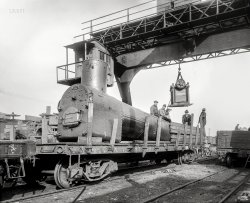
MAY CONTAIN NUTS

Search Shorpy
SHORPY ART

Framed or unframed, desk size to sofa size, printed by us in Arizona and Alabama since 2007. Explore now.
Join and Share
Ad-Free Shorpy
Shorpy is funded by you. Patreon contributors get an ad-free experience.
Learn more.

Recent comments
- Tomaeto, Tomahto
- Truck ID
- Horton Hears a ...
- From a buggy company came ...
- They call me Mister Horton
- Still Run
- Someone fed Jack some bad info.
- A Beautiful Machine
- It's official.
- Olive Brand Sportswear
- I still have a grudge against Texaco
- No GPS?
- CFG Bank Arena
- Van Lines
- Closed Station?
- John Vachon
- Folding Chairs
- TEXAGO
- Fragi-lay
- Classy
- Passenger seat
- No tipping
- The two front doors
- The theme song
- You are correct Dave.
- I was just there
- New to me
- Football-shaped thing
- Working all the live long day
- How do you stop slackers?
Member Photos
The Shorpy
Printporium
Printporium
Search Shorpy
Search results -- 30 results per page
- Duquesne Incline: 1900
- Pittsburgh, Pennsylvania, circa 1900-1910. "Duquesne Incline Railway." Mount Washington and ... knees can be seen on the bow. Probably used in the coal industry.
Improvement! This is one of the few scenic photos on Shorpy ... Posted by Dave - 08/02/2012 - 4:15pm -
![Duquesne Incline: 1900 Pittsburgh, Pennsylvania, circa 1900-1910. "Duquesne Incline Railway." Mount Washington and the Ohio River feature in this view, which includes the Point Bridge, a paint and varnish factory, a riverboat and the Graham Nut Company. 8x10 inch dry plate glass negative, Detroit Publishing Company. View full size.
View of downtown from the Duquesne InclineTaken just a week and a half ago. After posting the photo on my facebook page a friend referenced this post by Dave. Shorpy is one of my favorite sites!!
InterestingI'm wondering what is the white material that was used for sheathing the upper floor of that industrial building on the left. Looks like fabric.
Not there anymoreis the Lawrence paint building. It had stood abandoned for many years and was finally torn down 2 or 3 years ago. Also not there any more are the barren hillsides lining the shores of Pittsburgh's three rivers. I believe this is a direct result of the closure of all but a few steel mills and the pollution abatement efforts for those that remain.
Hoppin' TomThe Tom Dodsworth was a 182', 500 ton steamer built in Pittsburgh in 1871. She was called the "Hoppin' Tom" after setting a record time for the round trip between Pittsburgh and Cincinnati. On Dec 2 1900 she was involved in a collision with the steamer "Volunteer" near Swan Creek, Ohio resulting in the the sinking of 22 coal barges. Perhaps the photo was taken during repairs after the wreck. Dismantled circa 1924, her boilers were repurposed to construct road culverts in Pleasant County, W.Va.
Reports of the Department of Commerce and Labor, 1909
March 24 (1907).—Steamer Tom Dodsworth, while ascending the Ohio River near Moundsville, W. Va., with an empty tow of coal boats and barges, broke her port wrist in crank, after cylinder head, bent piston rod close to piston head, and threw pitman crosshead and piston overboard. No other damage done, and no one hurt. Estimated damage, $500.
Coal Age, Vol 7., 1915
The steamers "Thomas Dodsworth" and "F. M. Wallace," of the Monongahela River Consolidated Coal & Coke Co. cleared for Louisville Feb. 27 with tows of coal totaling about 1,200,000 bushels, also two freight barges each carrying 1400 tons of manufactured iron and steel.
IronsidesI'm pretty sure that the white top floor is sheathed in sheet metal.
Gone Green I'm amazed at the desert like conditions on the hillside. Maybe clear cutting to make it easier for development?
Isn't this also referred to as a vernacular railway? Or is that part of someone's vernacular?
[Maybe you're thinking of "funicular." - Dave]
Car safetyWere these cars pretty safe as far as reliable brakes and/or safety brakes? Was there ever a incident of them failing, to anyone's knowledge?
Lost opportunity I lived in Pittsburgh for nearly two years, and never made time to go up one of the inclines.
And I was as close as that bridge. On weekends I'd unwind by driving around the city in my Civic, crossing back and forth on the bridges and checking out the odd little neighborhoods.
Really cool picture, Kilroy. I'm pretty sure that those buildings up top weren't there in 1997. Especially that modern one at top right. I bet the great big empty expanses that lined the south shore of the Monongahela have been built up since then.
Up the creek... without a paddlewheel. Maybe removed to replace the paddles. The antlers on the pilot house indicate that the Tom Dodsworth won a steamboat race. This is an Ohio River sternwheel tow boat, small towing knees can be seen on the bow. Probably used in the coal industry.
Improvement!This is one of the few scenic photos on Shorpy where the view has markedly improved since it was taken. In fact, Pittsburgh is a much more beautiful city now, too.
A lot of this is still thereIncluding the incline itself, and Lawrence paint & varnish. In fact I remember the lettering was readable the last time I paid any attention to it. The odd-shaped building (a grain elevator, maybe for the brewery?) is gone, but I think the Nuts building is still there, too.
Of course this is one of the two inclines preserved in Pittsburgh, and it's a great trip.
SafetyI don't know about incidents at the Pittsburgh inclines, but there were a few accidents on the ones in Cincinnati. Since the two cars counterbalanced each other, if the cables snapped then both cars would fall to the bottom. That happened on the Main Street Incline in Cincinnati, when one car reached the top the cable pulled out of the front of the car and it plummeted to the bottom, killing many patrons. Since the other car was already at the bottom it was mostly unscathed. That said, extra cables and other safety measure were installed, and they tended to operate very safely and quietly overall.
The 19 inclinesHere are the locations of the 19 inclines of Pittsburgh. Click on them to see they names. Zoom to see the exact location of their tracks.
Lawrence Paint BuildingThat beautiful building isn't there any longer? What a shame. Seems like it would be prime loft space nowadays with such a picturesque view. My first (and only) visit to the downtown area was in '95 and we took the incline. I was very impressed with all of Pittsburgh.
+111Below is the same view from July of 2011.
(The Gallery, Boats & Bridges, DPC, Factories, Pittsburgh, Railroads)](https://www.shorpy.com/files/images/4a19421a.thumbnail.jpg)
- Plane No. 7: 1900
- ... 1824 and 1924 the Morris Canal served Boonton's iron industry between Phillipsburg and Jersey City. Iron crossed over the Jersey ... Hudson Canal, roughly the same time period, running from Pennsylvania coalfields to the Hudson River. Coal then moved on barges down the ... Posted by Dave - 12/15/2022 - 12:28am -
![Plane No. 7: 1900 Boonton, New Jersey, circa 1900. "Top of plane, Morris and Essex Canal." 8x10 inch dry plate glass negative, Detroit Photographic Company. View full size.
Read if so inclinedI didn't know this, so maybe others don't too:
A [canal] inclined plane is a type of cable railway used on some canals for raising boats between different water levels. Boats may be conveyed afloat, in caissons, or may be carried in cradles or slings.
This would be the long way roundAt least it would be today. Between 1824 and 1924 the Morris Canal served Boonton's iron industry between Phillipsburg and Jersey City. Iron crossed over the Jersey Hills by use of 23 lift locks and 23 inclined planes. Thank you, Kiwanis.
Painting of the Boonton LockI am so very happy to see this image Shorpy-fied!
My grandparents lived two blocks from the Boonton lock and plane. He, F. C. Wells, was a Manhattan architect and painter. In the 1940s (or maybe '50s) he created a rather surreal image of the "guard lock" at Boonton (attached). I don't know for certain, but I think he painted this collage of imagery over another painting -- as suggested by the church turrets in the background and the forested mountain on the right.
D&H CanalVery cool. I remember my father mentioning it a few times, he was born in 1917 in Irvington. Up here in Ulster County there are a couple of museums celebrating the Delaware and Hudson Canal, roughly the same time period, running from Pennsylvania coalfields to the Hudson River. Coal then moved on barges down the Hudson. It was built in ten years. There's an inland town along it’s its length called Summitville because it was the highest point on the canal. This being a more rural area, there are lots of parts remaining.
+120 YearsThe building on the left with the bay windows is still standing:
The inclined plane started by the intersection of Main Street and School Road. You can see where the canal and inclined plane were on this old map of Boonton.
Lots of great then-and-now photos (including another view of the top of the plane) at Boonton.org.
(The Gallery, Boats & Bridges, DPC, Railroads)](https://www.shorpy.com/files/images/SHORPY-4a07225a.thumbnail.jpg)
- Scenic Petoskey: 1908
- ... - thanks Dave.
Park it in Petoskey It looks like Pennsylvania Station, now at one end of Pennsylvania Park; the tracks still run ... stone.
Petoskey and Me Many years ago at an industry convention I met an appliance dealer from Petoskey. I don't remember ... Posted by Dave - 07/29/2012 - 6:12pm -
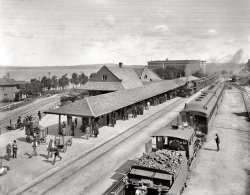
- Westinghouse Air-Brake: 1905
- Wilmerding, Pennsylvania, circa 1905. "Machine shop, Westinghouse Air-Brake Co." Company ... and was a rival of Thomas Edison in the early electrical industry. 8x10 inch dry plate glass negative, Detroit Publishing Company. ... Posted by Dave - 07/29/2012 - 10:10am -
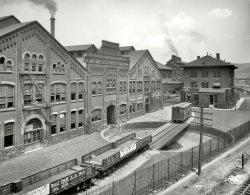
- Market Street: 1916
- Harrisburg, Pennsylvania, circa 1916. "Market Street." A highlight of this relatively ... Parthemore (1893 - 1960) who worked in the retail shoe industry for most of his life. The article and ad below are from the Harrisburg ... Posted by Dave - 07/30/2012 - 4:34pm -
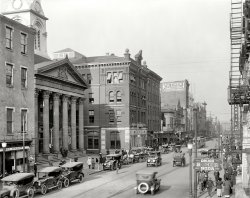
- Transit: 1906
- ... steamboat pushing a barge full of coal up (down?) river. Industry!!
The Grim Reaper standing up there on the left embankment!
... the left.
The Transit Built in 1889 at Brownsville, Pennsylvania. Spent most of its career in the Louisville harbor switching ... Posted by Dave - 08/01/2012 - 1:36pm -
![Transit: 1906 The Ohio River circa 1906. "Canal locks at Louisville, Kentucky." 8x10 inch dry plate glass negative, Detroit Publishing Company. View full size.
Planes, trains and automobiles... are spectacular here on Shorpy, but the steamboats, ah, the steamboats. How they beckon me.
Grandma would have been 9My grandmother was born in Louisville in 1897; she would have been familiar with sights like this. So, Shorpy shows us what our ancestors saw. Love Shorpy!
Then and nowPuzzling abotu this O went to google maps and forunt:
So it is a curve in the river where it dropa a bit, possiy once was rapids, and the locks alow boats to get around the drops. I bever knew! Someone will probably post when they got rebuilt into the modern version...
Thanks!
SteamboatsSic Transit gloria.
[Bever forunt! - Dave]
ModernityEarly 20th Century. The horrors and depradations of the Civil War finally beginning to recede into memory. America in the midst of the industrial revolution and poised on the brink of international dominance. How wonderfully sleek and bustling and modern this scene must have looked to a Kentuckian in 1906! That soaring steel bridge spanning the Ohio River in the background. The fine, solid stonework of the locks. The hissing, wheezing energy of the steamboat pushing a barge full of coal up (down?) river. Industry!!
The Grim Reaperstanding up there on the left embankment!
Jedi Knightpracticing on the walkway on the left.
The TransitBuilt in 1889 at Brownsville, Pennsylvania. Spent most of its career in the Louisville harbor switching barges. Sank in 1901 and was raised. Rebuilt in 1920 at Paducah, Kentucky, and renamed the A.W. Armstrong.
Early open type arc lamp The arc lamp in this photo is a very early open carbon type that was dominant in the 1880s and '90s, requiring very frequent maintenance. A single set of carbons lasted only a few hours before needing to be replaced. These were rendered obsolete by the late 1890s by enclosed double globe arc lamps, which could burn a single set of carbons for a week. The lamp shown here is a slightly modified version of an open lamp having two carbon rod sets instead of the usual one. When one set burned up the second set was energized.
This lamp may have remained in service later (1906) as it was likely switched on only when the locks were being operated at night to allow boats to pass. These early open lamps are extremely rare. Very few survive today.
(The Gallery, Boats & Bridges, DPC, Louisville)](https://www.shorpy.com/files/images/4a13343a.thumbnail.jpg)
- Underground Railroad: 1942
- November 1942. "Pittsburgh, Pennsylvania (vicinity). Montour No. 4 mine of the Pittsburgh Coal Co. Mine car ... in a state ripe with coal mining history and continued industry. Nearby is Collier Township, yet I never looked up the word! Thanks ... Posted by Dave - 09/13/2011 - 10:53am -
![Underground Railroad: 1942 November 1942. "Pittsburgh, Pennsylvania (vicinity). Montour No. 4 mine of the Pittsburgh Coal Co. Mine car operating off a trolley cable." Medium-format nitrate negative by John Collier for the Office of War Information. View full size.
Dress for the job you want.This boy gets bonus style points for wearing a necktie in a coal mine.
Don't lean backI hope that trolley wire is a safe low voltage, as it's just the right height to brush against or even use as a handrail.
Clean Cut GuyWWII has been on for almost a year. The mines must have been considered essential work places and that would bring with it deferment from the draft. I just get the feeling he's management and not labor.
AptonymicalThe photographer has a perfect last name for this job.
I wonder how many mine shoots he was assigned to.
What Dad was talking about...Now I know.
Office GuyMaybe he's in administration or perhaps a safety inspector - when it's time to go into the "field" he opens the trunk, retrieves a helmet and steps into his coveralls. I would schedule my visits to the job site toward the end of the day so I could go straight home and into the shower.
[Or maybe he's the guy who drove the train. - Dave]
Aptonymical? Yes!I read your comment because I was intrigued by the word "aptonymical". Though I haven't found a real definition for that term, I sense its meaning and when I looked up the word "Collier" I was amazed. I live in a suburb of Pittsburgh, in a state ripe with coal mining history and continued industry. Nearby is Collier Township, yet I never looked up the word! Thanks for pointing out the photographer's name. Simply amazing.
(The Gallery, John Collier, Mining, Pittsburgh, Railroads)](https://www.shorpy.com/files/images/8d23648u.thumbnail.jpg)
- Hotel Henry: 1908
- Circa 1908. "Fifth Avenue, Pittsburgh, Pennsylvania." Plenty of free parking for the automobilists among us. 8x10 inch ... heart of Pittsburgh, that glowing metropolis of untiring industry, stands a pre-eminent contribution to the city's greatness. It is a ... Posted by Dave - 07/30/2012 - 4:37pm -
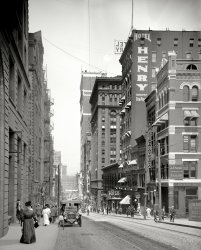
- Par Avion: 1918
- ... Shorpy. Although there was already a burgeoning aircraft industry in San Diego when Fleet moved here in 1935 (Lindbergh's "Spirit of St. ... about early air mail and its pilots, featuring the central Pennsylvania town of Bellefonte, the first refueling stop established for air ... Posted by Dave - 08/28/2012 - 1:41pm -
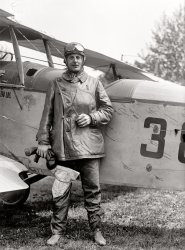
- 20,000 Volts: 1942
- ... My grandparents bought their first home in Sewickley, Pennsylvania, in 1941, a purchase made possible by Grandpa's job with Standard ... - Dave]
Very cool! I love the sciency/industry pictures here, and this one's a peach. Thanks.
Under pressure ... Posted by Dave - 07/23/2012 - 10:54am -
![20,000 Volts: 1942 July 1942. Melrose Park, Illinois. "Production of aircraft engines. Buick plant. Foreman F.I. Bowman shows Marietta Morgan how to operate this bomb-test machine used to test reconditioned spark plugs. A young Negro girl, Marietta had been a clerk in a meat market. Her lack of industrial experience, however, has been no handicap for her present war job in a large Midwest airplane plant. She's rapidly becoming a skilled and efficient machine operator." Medium format safety negative by Ann Rosener for the Office of War Information. View full size.
The Birth of OpportunityWorld War II was a crisis that also generated unprecedented opportunities across America. For individuals like Ms. Morgan, it was more than access to jobs. It was a means for accumulating the base of wealth needed for household formation. My grandparents bought their first home in Sewickley, Pennsylvania, in 1941, a purchase made possible by Grandpa's job with Standard Steel Spring Company, where he made armor plate, and Grandma's job with the American Bridge company, where she welded the hulls of LST ships. Prior to the war, their opportunities were limited to domestic work which paid them only enough to live on the premises of their employer. By the end of the war, they had furnished a home in which they would raise their daughters, send them to college, and ... well, you get the idea.
Little known side-effect20,000V does create an electric field that prompts excessive axillary discharge, referred to in common parlance as "pit stains".
I think the guy ...Is one of the Pep Boys. Which one, I'm not sure.
So easy a Negro girl can do it!Amazing how we used to talk and think we were making perfect sense.
Bomb tester?Yeah, ummmmm, do you have any other jobs available?
"Young Negro Girl"It's typical of the era that they chose a girl with a very White appearance.
[That might be a mistaken assumption. - Dave]
Thank you for posting thisLike the Anon Tipster of the "Birth of Opportunity" post, my great-aunt and great uncles also found opportunity during WWII. Both of my grandfathers served in segregated units during WWII (my maternal grandfather served in New Guinea). Opportunities in shipyards and migration away from the South led to college and graduate school educations, and the achievement of personal goals. I learned much from these older family members while growing up (I'm an African-American woman who was born in 1968). They were hard-working, patriotic people who believed deeply in education, civic engagement, and solid family values. The young lady in the photo and the people in the screen grab from the Library of Congress would have been their contemporaries. So often I log in to Shorpy and see images of people who feel familiar to me. They aren't always Black, but they tend to be the rural folk & working class strivers I knew and loved. Thank you, Dave.
Never, ever... would I allow bomb testing at my home.
20,000 VoltsThe machine is called a "Hi-Pot" for high potential. Its purpose is to expose a component under test with a very high voltage and very low current to determine at what level the tested component will break down and begin to conduct electricity.
At that time, they used a step-up transformer to achieve high voltage, and a mercury vapor rectifier tube to convert it to DC.
These are still in common use today, with solid state rectification.
The plant is still thereBut it's no longer owned by Buick; it now makes truck engines for International Harvester. I live about a half mile away and my home along with many others in my subdivision were built for wartime workers at this facility.
View Larger Map
Re: So easy a Negro girl can do it!Regarding the comment on the description being insulting to the black girl pictured, I actually didn't gather this at all. Save for use of the then-contemporary term "negro," I didn't feel the description was disparaging the young lady with regard to her race at all.
The description reads, "her lack of industrial experience has been no handicap for her present war job in a large Midwest airplane plant."
Remember, her prior job was as a meat market clerk, so one would naturally wonder if the transition was an easy one.
["Negro" is "disparaging"? - Dave]
Very cool!I love the sciency/industry pictures here, and this one's a peach. Thanks.
Under pressureMachines like this exist because a spark plug can fire just fine in free air, but fail to fire in compressed air. You can also check for air leakage around the body of the spark plug. This machine would have probably used air pressures around 6 to 8 times atmospheric, or about 90 to 120 psig.
Spark plugs can still be tested in machines like this, although the plugs are cheap enough now that they usually just get replaced. I wonder why an aircraft engine factory was using used plugs, though? Maybe the engines were built with a set of plugs, broken in, and then got a new set. During break-in, the piston rings wouldn't seal as well, so the plugs would tend to get fouled with oil - cleaning and testing them would let them be used to break in another engine.
"Bomb" here means "container that can hold pressure", a somewhat obscure usage of the word. Sometimes older people will refer to an aerosol can as a "spray bomb".
(Technology, The Gallery, Ann Rosener, WW2)](https://www.shorpy.com/files/images/8e11112u.thumbnail.jpg)
- City Sidewalks: 1938
- ... love that '37 Ford flatback sedan. Ford built some of the industry's greatest body shapes in the 1930s.
Driver Arms I really like ... changed much, but the traffic patterns have. That's Pennsylvania Avenue in the upper right corner, a portion which has since been ... Posted by Dave - 07/17/2012 - 10:25pm -
![City Sidewalks: 1938 Washington, D.C., circa 1938. "Street scene, U.S. Treasury, Fifteenth Street." Harris & Ewing Collection glass negative. View full size.
Phaeton in the snowNice to see a touring car (the '35 Ford Phaeton behind the taxi) in adverse weather. These cars had no side glass, so they were inexpensive, lightweight and stylish, but breezy! The side curtains were so cumbersome that I imagine sometimes they weren't worth the trouble, even in a car that could hit 80 mph.
I also love that '37 Ford flatback sedan. Ford built some of the industry's greatest body shapes in the 1930s.
Driver ArmsI really like the "slow/Stop" arm positions of the drivers of the delivery van and taxi cab while waiting for the '37 Ford to pull away and the lady to cross the street. Most young drivers today most likely not know the meaning of this signal! Common signal then as were the arm positions for left and right turns, too.
That's not a PCCThe streetcar looks like a PCC car, but it's actually a pre-PCC built in the mid 1930s before the PCC design was finalized.
Switch HittersThat's a cool looking bus. It looks like it goes both ways, like the streetcar, but the seats are all facing the front, and a bidirectional bus would be silly.
Back of the Ten-Dollar BillUntil late 1990s, the reverse of the U.S. $10 bill featured a streetscape very similar to this image. The buildings haven't changed much, but the traffic patterns have. That's Pennsylvania Avenue in the upper right corner, a portion which has since been closed to vehicular traffic in our post 9-11 world [Actually closed since 1996 - Dave]. The "streamlined" streetcar is one of the first of its kind anywhere, built in Philadelphia in 1935 by the J.G. Brill Company and is part of a batch serialed somewhere between 1001 and 1010. This is a close forerunner to the PCC streetcar featured in an earlier post.
Today's City SidewalksView Larger Map
My GrandmotherMy grandmother might very well be in this photo. She worked at the treasury dept for several years, including 1938. I wish there were some way to zoom in on this in a clear way to make out more details. It would be incredible to see!
[You can download a much larger version here. (Right-click link, choose "save file/target/link as.") - Dave]
(The Gallery, Cars, Trucks, Buses, D.C., Harris + Ewing, Streetcars)](https://www.shorpy.com/files/images/25885a.thumbnail.jpg)
- National Tube Works: 1910
- Pittsburgh, Pennsylvania, circa 1910. "Furnaces, National Tube Works." 8x10 inch dry plate ... River of Sweat, 1999.
McKeesport became a heavy-industry town. It was home to the largest producer of steel pipe and tubing in ... cities that suffered because of the decline of the steel industry. For a long while after U.S. Steel closed the plant in 1984, the ... Posted by Dave - 07/29/2012 - 1:32pm -
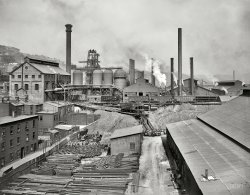
- The Happy Wanderer: 1918
- ... who adopted it, it was the Heisman Trophy of the auto industry!
Re: Warner Lenses I believe there may be just the tiniest ... were making trackless trolley coaches for Philadelphia, Pennsylvania's Rte. 66 on Frankford Ave. in 1955. Long ago, I think that they ... Posted by Dave - 03/11/2016 - 10:56am -
![The Happy Wanderer: 1918 "Marmon touring car, San Francisco, 1918." Latest entry in the Shorpy Index of Ill-Fated Phaetons. 5x7 glass negative by Christopher Helin. View full size.
Interesting headlight lensesI wonder what purpose was served by the designs in the glass.
[They're Warner headlight lenses. Click to enlarge. -tterrace]
Warner DangerThe Warner-Lenz may have been "resistless", but judging by the list of car makers who adopted it, it was the Heisman Trophy of the auto industry!
Re: Warner LensesI believe there may be just the tiniest bit of exaggeration in the maker's claims.
New Car, Used (?) TiresCurious - the car appears to be new - dealer plates, clean undercarriage, shiny paint, with tires totally scraped and scuffed. Were new tires optional?
Amazing finishAlways amazed and the amazing paint finish and body panel fit on these early cars.
Maypop tiresThose tires look old and have messed up sidewalls. Why are they on this new-looking dealer car?
tterrace's advert for the headlight lenses lists the car companies carrying them as standard equipment. It is, in retrospect, not a promising list.
White Sidewall TiresThis is the first time I have noticed the tires had white sidewalls on both sides. Today, white sidewalls are only on one side. When did that change and why?
Headlight lensesI have a 1914 Hudson with Warner Lenz headlight lenses.
I just like the looks of them.
One of America’s bestI read a magazine article several years ago about the five greatest cars ever produced in America, and the 1931 Marmon was one of them (I think it was Brock Yates who wrote the article). They consistently made excellent automobiles until the Great Depression forced them to go out of business (just like Duesenberg and Stutz). Anyway, that stuck in my mind because I had never heard of Marmon before I read that article.
Marmon BusinessMarmon did get back into the transportation business, they were making trackless trolley coaches for Philadelphia, Pennsylvania's Rte. 66 on Frankford Ave. in 1955. Long ago, I think that they also made side cars for motorcycles.
(The Gallery, Cars, Trucks, Buses, Chris Helin, San Francisco)](https://www.shorpy.com/files/images/SHORPY-920.thumbnail.jpg)
- Lever of Power: 1942
- August 1942. "Women in industry. Aircraft motor workers. A million-dollar baby, not in terms of money ... I could find was a Eunice Hancock Jobe, who was born in Pennsylvania in 1921, and died in Pa. in 2008. Her obituary, though, says Mrs. ... Posted by Dave - 04/27/2015 - 7:22am -
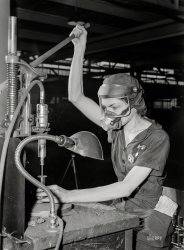
- Billet Chutes: 1908
- Homestead, Pennsylvania, circa 1908. "Billet chutes, Homestead Steel Works." 8x10 inch dry ... as ear protection in 1908. I guess it kept the ear horn industry alive.
Steel steel and more steel Looks like the chutes use old ... Posted by Dave - 08/08/2012 - 7:37pm -
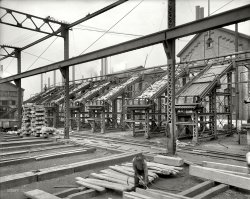
- Jones & Laughlin: 1941
- ... of the Jones and Laughlin Steel Corporation in Aliquippa, Pennsylvania, waiting for a bus to go home at the end of the afternoon shift." ... in Pittsburgh.
Steel and Football Aliquippa's main industry today is football. "Playing Through the Whistle: Steel, Football, and ... Posted by Dave - 10/24/2019 - 3:23pm -
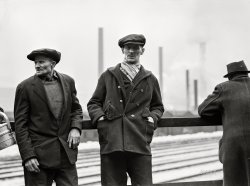
- City Terminal: 1941
- June 1941. Pittsburgh, Pennsylvania. "Carloads of fruits and vegetables at city terminal." Medium ... out - tag out" safety rules for machinery in all American industry, the railroads created a similar rule protecting workers on and around ... Posted by Dave - 01/31/2020 - 9:25pm -
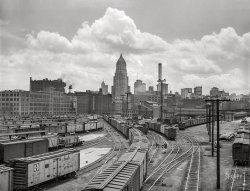
- Happy Thought: 1940
- ... My family were from the anthracite region in northeastern Pennsylvania. My aunt had a coal stove. It had to be kept burning all year ... with 25 patents, designed a duplex grate, which became an industry standard.
The company shipped $175,000 worth of stoves in 1917, ... Posted by Dave - 12/19/2018 - 12:41pm -
![Happy Thought: 1940 September 1940. "Mrs. Garland and her little boy. Family lives in the submarginal farm area of Rumsey Hill, near Erin, New York." Medium format acetate negative by Jack Delano for the Farm Security Administration. View full size.
Lots of PotsThat stove looks huge and can accommodate so many pots but I guess once you made the fire, you had to cook everything at once instead of making things one after another. Perhaps she had a large family (or planned to) and this was a wise purchase.
Another thought -- during harvest season my grandparents would hire threshers to come in and harvest everything in a short period of time. The farm wife was responsible for feeding them. This probably came in handy if used for those times too.
Shoe problemMr. Delano must have shown up when no one was ready. Maybe scurrying around to get their shoes on. The little boy either didn’t get both shoe on on decided he didn’t want to wear two shoes. Mother simply didn’t have time to tie her shoes, I suppose. Anyway, that is quite a remarkable stove!
[That's a baby shoe. Our young lad has both shoes on. - Dave]
Threshing, heat, and canningThat big stove is probably for a bunch of reasons, starting with the fact it was probably a main source of heat for the home. It also would come in handy for not only threshing season, but also canning, preserving, boiling down maple syrup, baking bread & pies, and even heating water for doing laundry. It's impressive how much oven you can use when you're doing all that.
Close your mouth, you'll catch a fly.That's what my old dad would tell me when my mouth was hanging open like this young lad's.
Give me gas (stove that is)The stove was a critical appliance. My family were from the anthracite region in northeastern Pennsylvania. My aunt had a coal stove. It had to be kept burning all year round. It was a pain to re-light so extended trips from home were few. In addition to cooking, it was the primary source of heat and hot water. There were metal grates in the floors upstairs to let the heat rise up in the winter. For really cold days she had a second coal heater in the "parlor," as she called it. She had this setup until she had to move into a "home."
Maybe the result of living through the Depression, but my family never updated anything without good reason. Things were used until they broke and couldn't be repaired.
Shorpy StoveNice placement.
The Stove That Made Pittston FamousFounded in 1869, the Pittston Stove Company's business took off after 1873, when Samuel Smythe, an engineering pioneer with 25 patents, designed a duplex grate, which became an industry standard.
The company shipped $175,000 worth of stoves in 1917, the equivalent of $3.2 million today. The one shown in this ad has much fancier ironwork but the components are similar the Garland family's version.
Re: Give me gas (stove that is) I have had many conversations as a curious teen, and even more curious adult with my grandparents, as well as my husband's Indiana farmer grandparents of German farm family roots over the last 40 years. In those conversations, I discovered that due to not only the Great Depression, but general farm family economics, combining a lifetime of thrifty farming ways, plus the aforementioned Depression, AND WWII, they just lived that way, because that's the way things were. While "the men" - meaning the grandfather and any uncles that remained to follow in their father's footsteps - ruled the roost regarding not only farm operations, but economic ones as well. Grandmothers - mothers at that time, of course - ruled the home, and all operations taking place inside it, but only to the point where the economy would allow. The furnishing of the kitchen, the sewing room, the canning storage, water supply, and other utilities were ruled by the amount of money available coming from the economies of the farm operations, which always came first. If electricity were to be furnished to the property, it came to benefit the running of the farm first, and then the house IF there was enough left over to do so. So, the harder the men worked, and the more money that came from those efforts, the more everyone would benefit. Updating the features of the farm home was practically impossible not only during depression times, as there was no money to do so, until the Federal government and the FSA began getting involved in helping farm families pull themselves out of the Great mire they found themselves buried in during the very late thirties.
But, it all came to a halt during the War years, because even though there was more money in the bank finally, there was little to nothing to buy! Restrictions, rationing and priorities on metals reduced new farm equipment to absolute minimums, if not down to nothing to be had at all. Even repair parts were almost impossible to come by. Same for tractor tires, truck tires, wagon tires, even bicycle tires! So many farm families lived miles and miles "from town" they had difficulty getting there to buy anything, if there was anything to buy. Going to the local co-op for seed, feed, and fertilizers - also difficult to get in needed quantities - was about as close to shopping as many farmers or their wives would get for years.
My husband's grandmother never learned to drive, and she was relegated to sending a list with grandpa to get the things she needed, so she had to depend on him entirely for several years to get her shopping done. The only time she left the house for years was to go to church down the road about two miles on Sunday mornings. Sometimes she would be able to send mail orders in from her Sears catalogs, if they had what she wanted for the money she had to spend. She had three sons and one daughter, born in a period of 36 months from the birth of the first to the last, all by C-sections, in the mid-30's, so those trips to the hospital were also rare outings! And extended rests, with other local church acquaintance farm wives coming to help her out for the first few weeks after each one came. Cloth diapers were washed daily in a bucket, rinsed twice in the wash tub, run through the wringer, and hung on the line in the sun to dry. Laundry wasn't just a Monday only job, with farmer's overalls getting filthy on a daily basis. Nobody had a week's worth of clothing to get from Monday to Sunday.
Gasoline restrictions and rationing certainly didn't help that, as you didn't get far on three gallons per week. Gasoline meant for farm equipment only had been colored with a red dye, and if you were found to be running farm gas in your automobile, there was severe fines that could be levied. So, keeping things running, and fixing instead of replacing were the rules of the day all during the War years as well. Once all those restrictions, rationing, priorities, etc., were over with, it wasn't so easy to just start throwing things out and buying new. Not when you had been doing things that way practically all your life.
Mrs. Helen Struble Garland, age 31This is most likely Helen Garland and her 3-year old son Chauncey. Per the 1940 census, Helen lived with her husband Clarence and five young sons in Van Etten, NY, where her husband worked as a woodcutter. Helen and Clarence both lived into their eighties.
(The Gallery, Jack Delano, Kids, Kitchens etc., Rural America)](https://www.shorpy.com/files/images/SHORPY-8c03149a.thumbnail.jpg)
- The Ice Wagon: 1923
- ... where the ice came from? I remember in the Northwestern Pennsylvania town of Stoneboro, harvesting ice from near-by Sandy Lake was a major industry. It was cut out in large blocks and stored on layers of straw in the ... Posted by Dave - 01/22/2014 - 11:36am -
![The Ice Wagon: 1923 New Orleans circa 1923. "Upper stories of buildings with wrought iron balconies." 4x5 nitrate negative by Arnold Genthe. View full size.
Real (ICE) Men!My paternal grandfather was an iceman. Born in 1890, he lived in the "Hell's Kitchen" area of NYC at 39th Street and 11th Avenue.
He plied his trade in this same area, and believe me, the buildings were a lot higher than the ones in this photo, and most had NO elevators back then, so he carried the ice up on his back.
Even after moving to Astoria, Queens, he worked long exhausting days, and well past his 65th birthday. I remember, as a small child, that after working all day, he would bounce me on his knee, and play with me, sometimes for hours.
As I sit typing this in my soft, cushy office, I can't help thinking that I wish I had half the character and strength this man had. RIP Grandpa!
Cast not wroughtGiven the detail of the uprights and arched overheads, the railing system is most likely cast iron not forged wrought iron. By the late 1800's and into the early 1900's cast iron railings, and even whole building facades, were possible. Indeed, they took off in popularity primarily because they allowed for intricate designs that were too difficult to produce via forge work.
Looks like a little Theft.. Looks like there is a home made "tap" of the utility going on (top center wires)Some one has thrown a weighted wire over the open wire and run it along the roof top. Still a common means of getting power south of the border and other poorer parts for the world.
Wonder where?Wonder where the ice came from? I remember in the Northwestern Pennsylvania town of Stoneboro, harvesting ice from near-by Sandy Lake was a major industry. It was cut out in large blocks and stored on layers of straw in the town's ice house, to last often into the summer! I suppose they and other enterprising northern towns exported some as well.
[It would have been made locally in a commercial ice plant, the first of which opened in New Orleans in 1868. -tterrace]
Looks just the same todayExcept for the the ice wagon and above ground wires, this part of Royal St looks just the same today. View is of 1127, 1133, and 1135 Royal St photographed from the second floor balcony of the Lalaurie mansion (aka "the haunted house on Royal St").
(The Gallery, Arnold Genthe, New Orleans)](https://www.shorpy.com/files/images/SHORPY_7a02783a.thumbnail.jpg)
- The Lady in Red
- ... M. Archer, owners of the Archer Camera Shop in Titusville, Pennsylvania, seen here earlier . Scan from an early kodachrome stereo slide ... purchased for a new war job, or replaced for your war industry (or farm?) job. Towards the end of the war, everyone was down to two ... Posted by ceraurus - 10/19/2018 - 7:24pm -
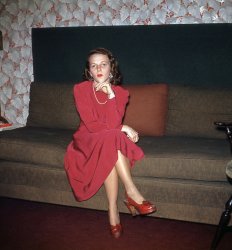
- America's Last Small City Streetcar: 1959
- ... practically rendered a ghost town, having lost its steel industry and suffered a devastating flood. Car 350 is today preserved at the Pennsylvania Trolley Museum at Arden, PA.
A subsequent submission will ... Posted by prrvet - 06/27/2020 - 11:10am -
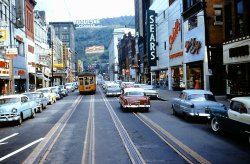
- Flatcar Follies: 1920
- ... stationary boilers and steam engines for the oil industry.
"Locomotive Style" Boiler for Stationary Use This is ... one F&T boiler, on display in various places in the Pennsylvania oil country. There are several F&T engines at Coolspring ... Posted by Dave - 05/21/2018 - 11:40am -
